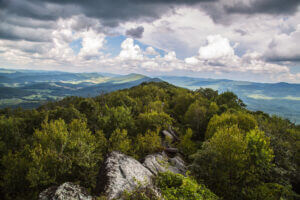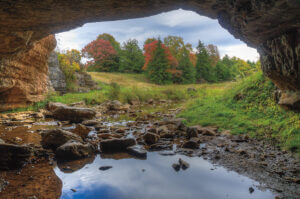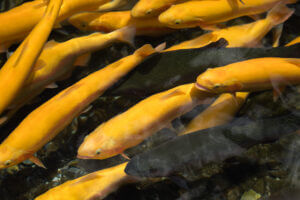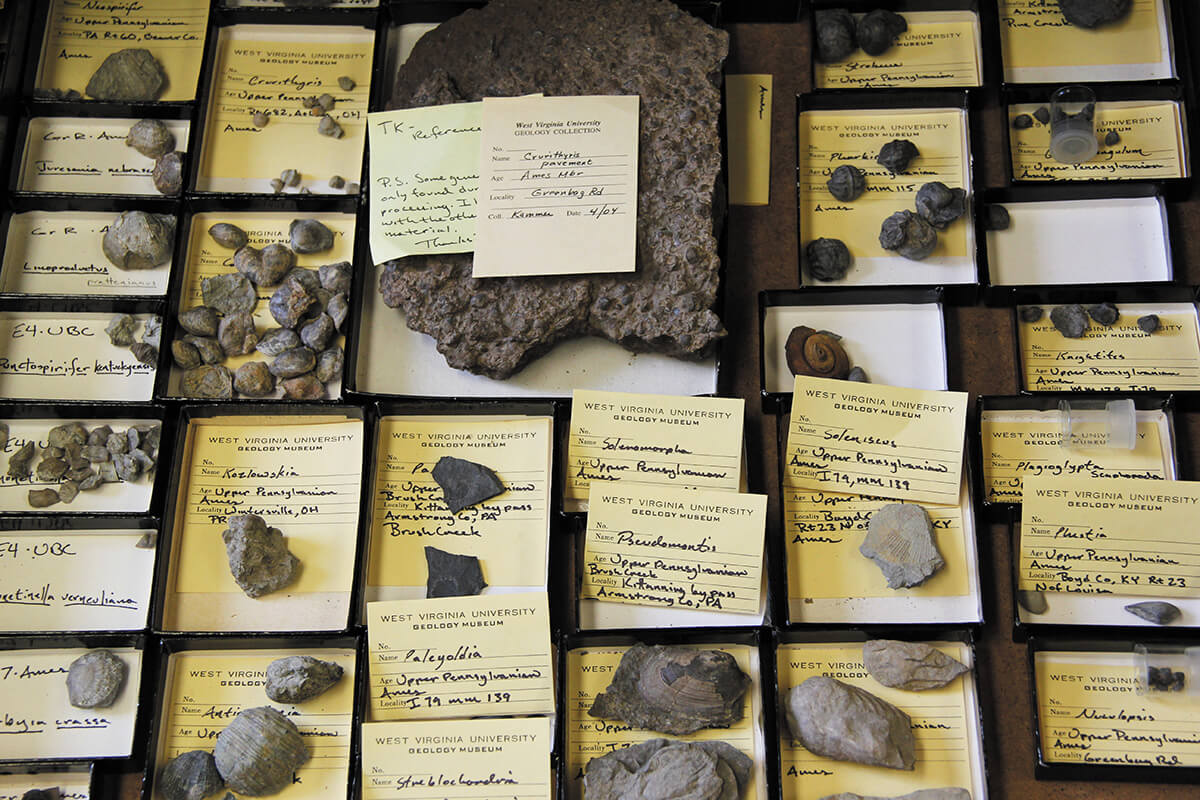
Fossils in West Virginia are 400-million-year-old relics from an unimaginable time.

This story was originally published in the July 2015 issue of Wonderful West Virginia magazine. To subscribe, visit wonderfulwv.com.
Written by Hope Hart
Photographed by Katie Griffith
Standing off to the side of a curved road, Robert Peck’s eyes are sharp and curious as he examines the outcrop in front of him. With dirt and gravel crunching beneath his boots, he walks closer to the formidable crag. The rock bed stands tall, boasting layer upon layer of stacked limestone, dusty from erosion and dotted with vegetation. Lowering to his hands and knees, Peck inspects the pieces of rock that have fallen to the bottom of the outcrop. Picking one up, he brushes dust off the uneven surface of a shell imprint. His suspicions are confirmed—he has found a fossil.
Peck, from Hinton, has always been a collector. When a house fire in 1992 destroyed the prized stamp collection he started with his father as a child, he was at a loss for how to fill the void, and his collecting instincts lay dormant. Then, in 1999, when he was teaching physical sciences at Concord University in Athens, West Virginia, he went on a geology field trip. “Suddenly everything just clicked,” Peck says. “You see this rock outcrop, you look closely, and you begin to recognize that it’s not just a rock outcrop, there are fossils here. You realize, ‘Hey, these are creatures.'”




A self-proclaimed child at heart, Peck began seriously hunting and collecting fossils after that first trip, fueled by his insatiable curiosity. His basement began to fill with fossils. “I got so many, I realized it was more than a collection, it was a research collection. I thought I was finding things no one had seen before,” Peck says. In 2005, while collecting in Mercer County, near Oakvale, he found a rostroconch, a type of extinct mollusk. Similar to a small clam with two symmetrical ribbed shells, it was a newly discovered species of rostroconchia, and Peck published his find in the Journal of Paleontology that same year. The specimens are now resting in the reserve collections at the National Museum of Natural History in Washington, D.C. “You see something that looks a little different than the other rocks, and once you start recognizing them, you find amazing things. It’s the history of life on earth,” Peck says. After his first discovery, he made another, this time a new species of non-marine tubeworm curled in a fossilized coil. Peck’s fossils are currently in museum reserves around the world, including the Carnegie Museum of Natural History in Pittsburgh and the Peabody Museum at Yale University in Connecticut.

These organisms lived when the state was once covered by a shallow sea about 500 million years ago, making West Virginia a rich source of marine invertebrate fossils and corals. Plant fossils can be found along the coal seams that weave throughout the state and in shale deposits that also boast the remains of marine organisms like trilobites and snails. In limestone, a collector can find fossils of marine life that lived in shallow waters, including the most abundant animal fossil in West Virginia, a type of extinct marine invertebrate called a brachiopod.
Brachiopod fossils found in the state can be anywhere from 350 to 425 million years old. Their small, textured shells have been preserved by layers of sediment deposits that covered the organism on the ancient seafloor as the waters retreated over time. After millions of years the sediment compressed and hardened into rock. “You’re looking at fossils that were originally alive on the seabottom and, for the most part, where you find them is where they died,” says Ron McDowell, a senior research geologist at the West Virginia Geological and Economic Survey in Morgantown. McDowell recommends looking for brachiopods near Elkins along the state highway Corridor H, also known as U.S. Route 48. As long as you park safely off the highway, collectors can go right up to the ancient rock to find samples. Just north of Elkins sits a two-mile stretch of outcrops where many fossils and a thrilling variety of rock layers are exposed. “The rocks are sitting at about a 50- or 60-degree angle, which means you can walk all the way along the outcrop and you go through rock bed after rock bed—it’s beautiful exposure,” McDowell says.
Jayson Kowinsky, an experienced fossil collector from Pittsburgh who has traveled the world for his hobby, visits West Virginia yearly to look for specimens to add to his collection. He recommends taking a scenic drive to the Eastern Panhandle of the state on West Virginia State Route 29. On that route, between the towns of Delray and Rio, road cuts have exposed the Mahantango Formation, an approximately 390-million-year-old siltstone and shale layer that sits right on top of the Marcellus Shale. Here, Kowinsky says, it’s as simple as flipping over a few rocks to find a brachiopod or two. Another roadside quarry sits near the Lost River just west of Wardensville on West Virginia Route 55 where you can find corals and trilobites. Deciduous and coniferous trees alike provide some shade for the dusty limestone walls, making the area a great location to fossil hunt. “Make sure to look at the rock that has already fallen. Especially in the early spring, after the winter erosion, you’ll find fossils that have fallen off at the bottom,” Kowinsky says.
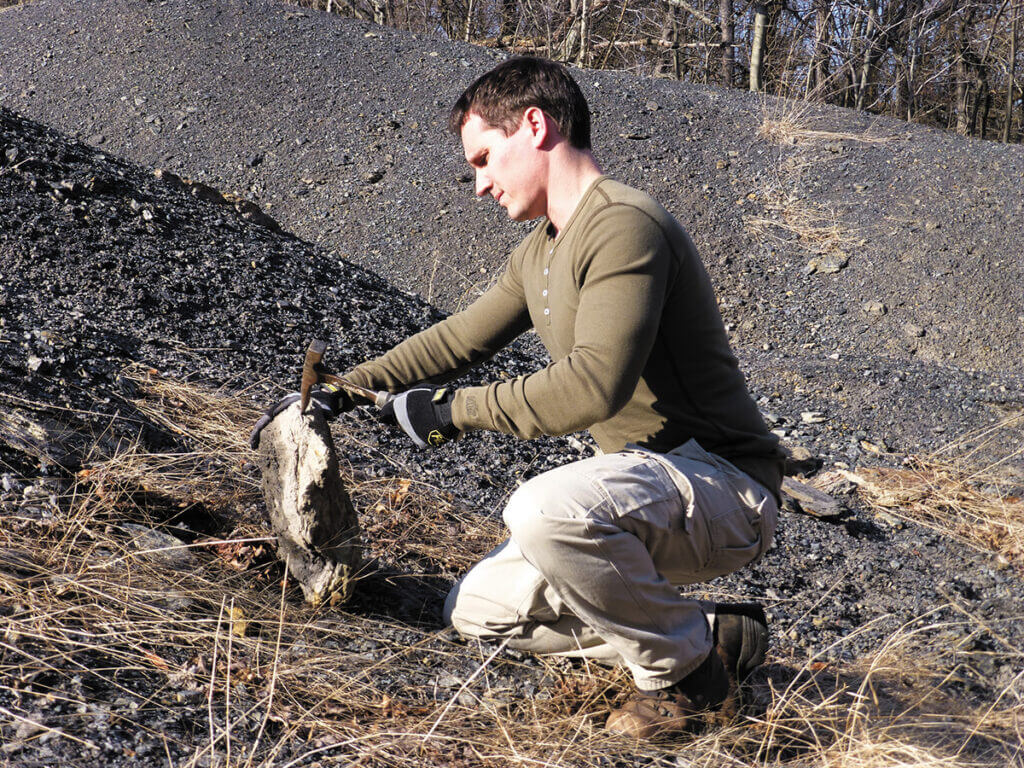
Equipped with nothing but a rock hammer, safety goggles, and a magnifying glass, the amateur fossil collector can visit these sites and find prehistoric treasures of their own. Since rock formations can be fragile, collectors advise parking safely off of roads and highways but not so close to the outcrops that tumbling rocks can hit your car. Avoid interstates and opt to travel the many smaller state and county roads that will provide a more scenic adventure, being mindful of private property.

The preparation and precautions necessary to fossil hunt are worth the experience. “The best part of fossil hunting is you never know what you are going to find—you never know what’s in the rock. One day you might not find anything, and the next day you find something and you are calling a museum,” Kowinsky says. He, like Peck, has fossils in museum collections. Today’s collectors follow a pastime rooted in the state’s long fossil history.
In 1796, prehistoric animal bones were found in a cave in what is now Monroe County and sent to Thomas Jefferson at Monticello in Virginia. Jefferson was an avid paleontologist at the time. Described as the “Bones of a Tremendous Animal of the Clawed kind” by Colonel John Stuart, the pioneering western Virginia explorer who discovered them, the large, terrifying claw-like fossils were first believed to be from a giant extinct species of lion and were a major discovery in North America. Later identified as the remnants of a 35,000-year-old giant ground sloth, the fossil was officially named Megalonyx jeffersonii, meaning “great claw,” and became West Virginia’s state fossil in 2008. “One of the greatest thrills of looking for fossils is knowing you are the first person on the face of the planet to see these things and hold them in your hand,” Peck says. “That’s the fascination in fossil hunting.”

For more information on local fossil hunting, contact the West Virginia Fossil Club and other local organizations.
This story was originally published in the July 2015 issue of Wonderful West Virginia magazine. To subscribe, visit wonderfulwv.com.




